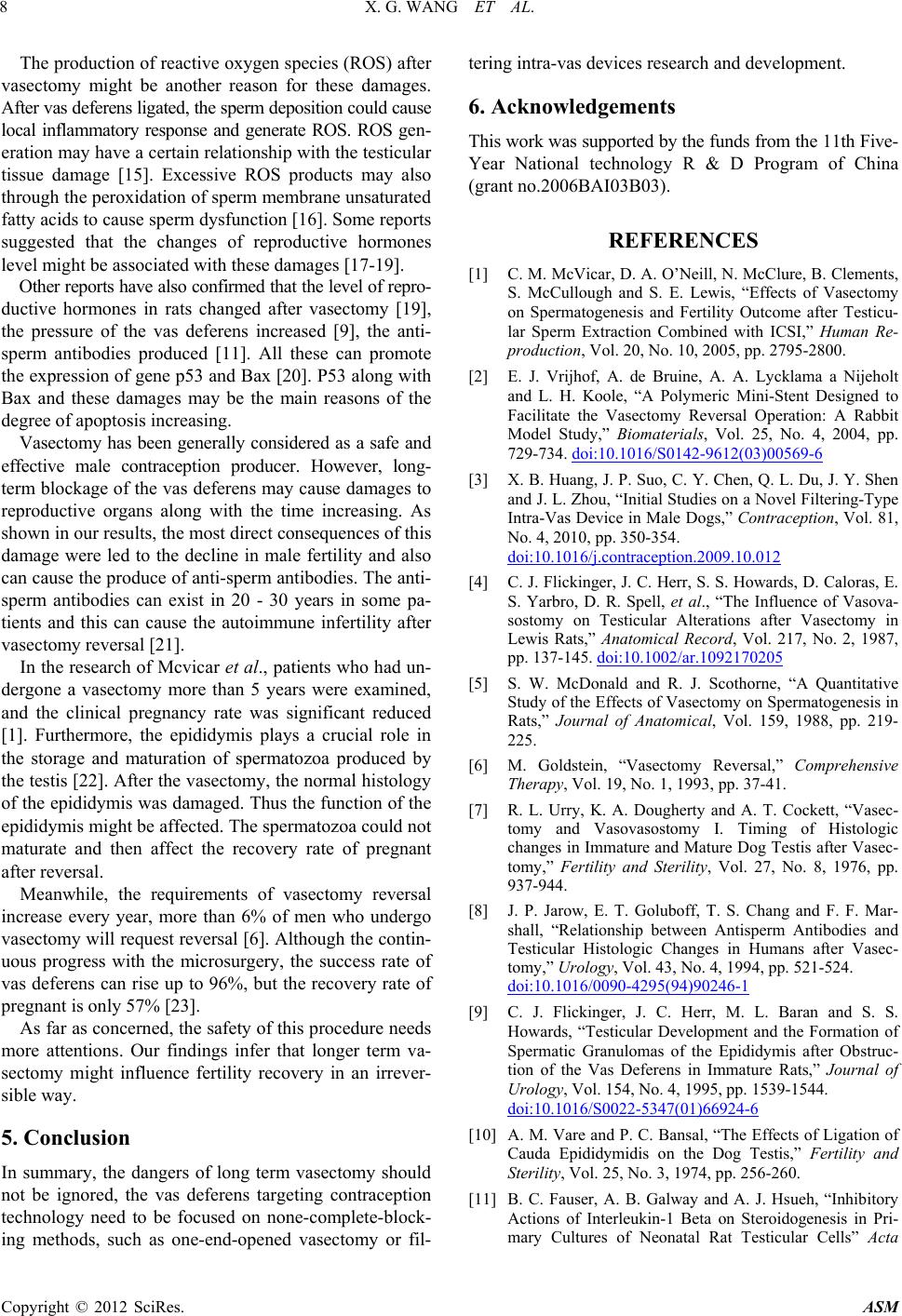
X. G. WANG ET AL.
8
The production of reactive oxygen species (ROS) after
vasectomy might be another reason for these damages.
After vas deferens ligated, the sper m deposition cou ld cause
local inflammatory response and generate ROS. ROS gen-
eration may have a certain relationship with the testicular
tissue damage [15]. Excessive ROS products may also
through the peroxida tion of sperm membrane unsaturated
fatty acids to cause sperm dysfunction [16]. Some reports
suggested that the changes of reproductive hormones
level might be associated with these damages [17-19].
Other reports have also confirmed that the level of repro-
ductive hormones in rats changed after vasectomy [19],
the pressure of the vas deferens increased [9], the anti-
sperm antibodies produced [11]. All these can promote
the expression of gene p53 and Bax [20]. P53 along with
Bax and these damages may be the main reasons of the
degree of apoptosis increasing.
Vasectomy has been generally considered as a safe and
effective male contraception producer. However, long-
term blockage of the vas deferens may cause damages to
reproductive organs along with the time increasing. As
shown in our results, the most direct consequences of this
damage were led to the decline in male fertility and also
can cause the produce of anti-sperm antibodies. The anti-
sperm antibodies can exist in 20 - 30 years in some pa-
tients and this can cause the autoimmune infertility after
vasectomy reversal [21].
In the research of Mcvicar et al., patients who had un-
dergone a vasectomy more than 5 years were examined,
and the clinical pregnancy rate was significant reduced
[1]. Furthermore, the epididymis plays a crucial role in
the storage and maturation of spermatozoa produced by
the testis [22]. After the vasectomy, the normal histology
of the epididymis was damaged. Thus the function of the
epididymis might be affected. The spermatozoa could not
maturate and then affect the recovery rate of pregnant
after reversal.
Meanwhile, the requirements of vasectomy reversal
increase every year, more than 6% of men who undergo
vasectomy will request reversal [6]. Although the contin-
uous progress with the microsurgery, the success rate of
vas deferens can rise up to 96%, but the recovery rate of
pregnant is only 57% [23].
As far as concerned, the safety of this procedure needs
more attentions. Our findings infer that longer term va-
sectomy might influence fertility recovery in an irrever-
sible way.
5. Conclusion
In summary, the dangers of long term vasectomy should
not be ignored, the vas deferens targeting contraception
technology need to be focused on none-complete-block-
ing methods, such as one-end-opened vasectomy or fil-
tering intra-vas devices research and development.
6. Acknowledgements
This work was supported by the funds from the 11th Five-
Year National technology R & D Program of China
(grant no.2006BAI03B03).
REFERENCES
[1] C. M. McVicar, D. A. O’Neill, N. McClure, B. Clements,
S. McCullough and S. E. Lewis, “Effects of Vasectomy
on Spermatogenesis and Fertility Outcome after Testicu-
lar Sperm Extraction Combined with ICSI,” Human Re-
production, Vol. 20, No. 10, 2005, pp. 2795-2800.
[2] E. J. Vrijhof, A. de Bruine, A. A. Lycklama a Nijeholt
and L. H. Koole, “A Polymeric Mini-Stent Designed to
Facilitate the Vasectomy Reversal Operation: A Rabbit
Model Study,” Biomaterials, Vol. 25, No. 4, 2004, pp.
729-734. doi:10.1016/S0142-9612(03)00569-6
[3] X. B. Huang, J. P. Suo, C. Y. Chen, Q. L. Du, J. Y. Shen
and J. L. Zhou, “Initial Studies on a Novel Filtering-Type
Intra-Vas Device in Male Dogs,” Contraception, Vol. 81,
No. 4, 2010, pp. 350-354.
doi:10.1016/j.contraception.2009.10.012
[4] C. J. Flickinger, J. C. Herr, S. S. Howards, D. Caloras, E.
S. Yarbro, D. R. Spell, et al., “The Influence of Vasova-
sostomy on Testicular Alterations after Vasectomy in
Lewis Rats,” Anatomical Record, Vol. 217, No. 2, 1987,
pp. 137-145. doi:10.1002/ar.1092170205
[5] S. W. McDonald and R. J. Scothorne, “A Quantitative
Study of the Effects of Vasectomy on Spermatogenesis in
Rats,” Journal of Anatomical, Vol. 159, 1988, pp. 219-
225.
[6] M. Goldstein, “Vasectomy Reversal,” Comprehensive
Therapy, Vol. 19, No. 1, 1993, pp. 37-41.
[7] R. L. Urry, K. A. Dougherty and A. T. Cockett, “Vasec-
tomy and Vasovasostomy I. Timing of Histologic
changes in Immature and Mature Dog Testis after Vasec-
tomy,” Fertility and Sterility, Vol. 27, No. 8, 1976, pp.
937-944.
[8] J. P. Jarow, E. T. Goluboff, T. S. Chang and F. F. Mar-
shall, “Relationship between Antisperm Antibodies and
Testicular Histologic Changes in Humans after Vasec-
tomy,” Urology, Vol. 43, No. 4, 1994, pp. 521-524.
doi:10.1016/0090-4295(94)90246-1
[9] C. J. Flickinger, J. C. Herr, M. L. Baran and S. S.
Howards, “Testicular Development and the Formation of
Spermatic Granulomas of the Epididymis after Obstruc-
tion of the Vas Deferens in Immature Rats,” Journal of
Urology, Vol. 154, No. 4, 1995, pp. 1539-1544.
doi:10.1016/S0022-5347(01)66924-6
[10] A. M. Vare and P. C. Bansal, “The Effects of Ligation of
Cauda Epididymidis on the Dog Testis,” Fertility and
Sterility, Vol. 25, No. 3, 1974, pp. 256-260.
[11] B. C. Fauser, A. B. Galway and A. J. Hsueh, “Inhibitory
Actions of Interleukin-1 Beta on Steroidogenesis in Pri-
mary Cultures of Neonatal Rat Testicular Cells” Acta
Copyright © 2012 SciRes. ASM